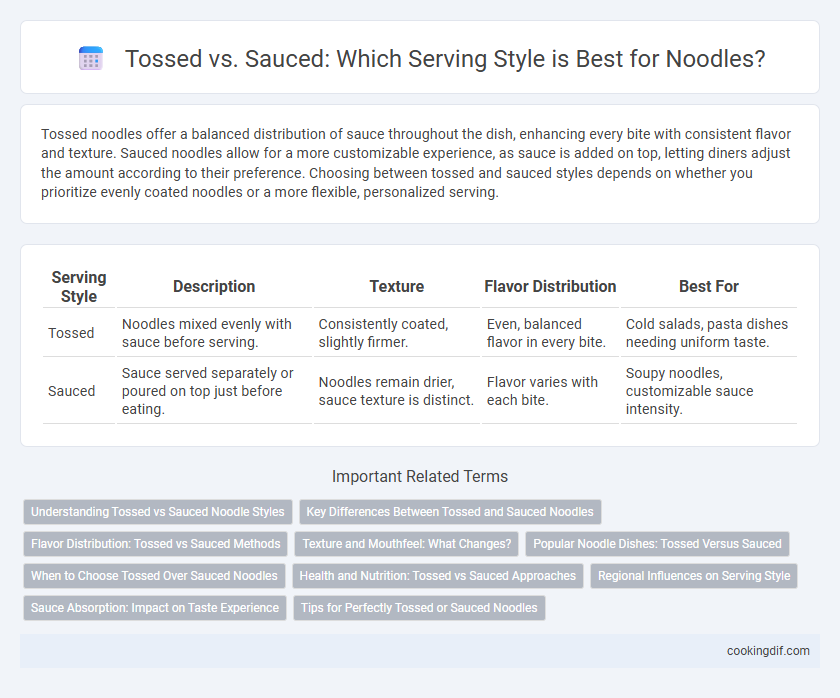Tossed noodles offer a balanced distribution of sauce throughout the dish, enhancing every bite with consistent flavor and texture. Sauced noodles allow for a more customizable experience, as sauce is added on top, letting diners adjust the amount according to their preference. Choosing between tossed and sauced styles depends on whether you prioritize evenly coated noodles or a more flexible, personalized serving.
Table of Comparison
| Serving Style | Description | Texture | Flavor Distribution | Best For |
|---|---|---|---|---|
| Tossed | Noodles mixed evenly with sauce before serving. | Consistently coated, slightly firmer. | Even, balanced flavor in every bite. | Cold salads, pasta dishes needing uniform taste. |
| Sauced | Sauce served separately or poured on top just before eating. | Noodles remain drier, sauce texture is distinct. | Flavor varies with each bite. | Soupy noodles, customizable sauce intensity. |
Understanding Tossed vs Sauced Noodle Styles
Tossed noodles are coated evenly by mixing the pasta with sauce and ingredients, ensuring every strand absorbs flavor and texture. Sauced noodles, on the other hand, are plated first and then topped with sauce, allowing for a contrast between the dry noodle base and the richly flavored sauce on top. Understanding these styles enhances culinary techniques and affects the dish's flavor distribution and presentation.
Key Differences Between Tossed and Sauced Noodles
Tossed noodles are mixed evenly with ingredients such as vegetables, proteins, and seasonings, ensuring each strand is coated and flavors are well integrated. Sauced noodles, on the other hand, have sauce poured over them as a finishing touch, often leaving some areas drier and highlighting the sauce's texture and taste separately. The key difference lies in the distribution and integration of flavors, with tossed noodles offering a uniform taste experience while sauced noodles emphasize distinct contrasts between noodles and sauce.
Flavor Distribution: Tossed vs Sauced Methods
Tossed noodles ensure an even coating of sauce, allowing each strand to absorb flavors fully, creating a balanced taste in every bite. Sauced noodles often have sauce concentrated on top or around the dish, which can lead to uneven flavor distribution and isolated bursts of taste. For consistent flavor integration, the tossed method enhances the overall sensory experience by blending sauce and noodles thoroughly.
Texture and Mouthfeel: What Changes?
Tossed noodles maintain a distinct, firmer texture with each strand coated lightly, preserving individual bite and chewiness, while sauced noodles absorb more moisture, resulting in a softer, more unified mouthfeel. The sauce can enhance creaminess or viscosity, altering how the noodles slide across the palate and intensifying flavor distribution. This change in texture and mouthfeel significantly impacts the eating experience, highlighting the importance of sauce consistency and noodle type in dish preparation.
Popular Noodle Dishes: Tossed Versus Sauced
Popular noodle dishes showcase two distinct serving styles: tossed and sauced. Tossed noodles, such as Pad Thai and Lo Mein, are mixed thoroughly with ingredients and seasonings, providing a balanced flavor in every bite. Sauced noodles, like Spaghetti Bolognese or Japanese ramen, are served with rich, flavorful sauces that coat or pool around the noodles, emphasizing the sauce's texture and taste.
When to Choose Tossed Over Sauced Noodles
Tossed noodles are ideal when you want to evenly coat each strand with a light layer of flavor, such as in cold soba or sesame noodles, ensuring a balanced texture and taste. Choose tossed noodles for dishes that emphasize a dry, slightly separated bite where each ingredient maintains its distinctiveness. Sauced noodles, in contrast, suit recipes requiring a rich, concentrated sauce that clings heavily, like in traditional spaghetti marinara or chow mein.
Health and Nutrition: Tossed vs Sauced Approaches
Tossed noodles retain more nutrients as the ingredients are mixed without heavy sauces that often contain added sugars, fats, and sodium. Sauced noodles may increase calorie and sodium intake due to concentrated sauce ingredients, impacting overall health negatively if consumed frequently. Choosing tossed styles with lighter dressings or fresh vegetables enhances fiber and vitamin intake, supporting a balanced diet.
Regional Influences on Serving Style
Regional influences significantly shape the serving style of noodles, with tossed preparations popular in East Asian cuisines like Chinese and Japanese, where noodles are typically stir-fried or mixed with ingredients to enhance texture and flavor. In contrast, sauced noodles dominate Southeast Asian and Italian traditions, emphasizing rich, often slower-cooked sauces poured over or mixed with the noodles to create a hearty, cohesive dish. Variations in climate, local ingredients, and cultural preferences contribute to these distinct serving styles, reflecting the culinary heritage of each region.
Sauce Absorption: Impact on Taste Experience
Tossed noodles, coated evenly with sauce, allow for more thorough sauce absorption, enhancing flavor intensity with each bite. In contrast, noodles served with sauce on the side may retain distinct textural contrasts but often result in less integrated taste profiles. The method of sauce application directly influences the sensory experience, affecting the balance between noodle texture and sauce richness.
Tips for Perfectly Tossed or Sauced Noodles
To achieve perfectly tossed noodles, ensure the sauce evenly coats each strand by combining noodles and sauce in a large bowl while stirring vigorously to avoid clumps or dryness. For sauced noodles, ladle the sauce generously over the plated noodles just before serving to maintain a distinct texture contrast and prevent sogginess. Use ingredients like olive oil or butter as a base to improve sauce adherence and enhance flavor integration.
Tossed vs sauced for serving style Infographic

 cookingdif.com
cookingdif.com